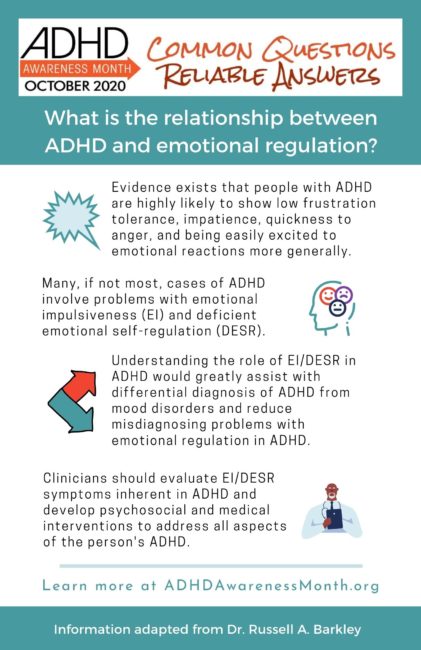During the first 170+ years of its medical history, attention deficit hyperactivity disorder (ADHD) and its precursor disorders were believed to involve deficits in emotional inhibition and self-regulation along with the core problems with attention and hyperactive-impulsive behavior. Yet, beginning in the 1960s, especially with the second edition of the Diagnostic and Statistical Manual for Mental Disorders (DSM-II: APA, 1968), the symptoms of emotional impulsiveness (EI) and deficient emotional self-regulation (DESR) were divorced from the core deficits of ADHD, being treated as merely associated problems that may arise in some cases, if these problems were acknowledged at all. This led to most people, clinicians included, excluding emotional self-regulation from their understanding of and theories about the nature of ADHD.

Emotional impulsiveness refers to the expression of provoked emotional reactions to events more quickly than is the case in typical people. Being impatient, having a low frustration tolerance, being easily excitable or emotionally aroused, expressing more forceful primary emotions when provoked, quickness to anger, and other impulsive emotional reactions illustrate this deficit in emotion regulation. DESR refers to the inability or difficulty with gaining control over strong emotions that have been provoked by events so as to inhibit their public expression, down regulate or reduce their severity, more quickly engage in efforts at self-calming, and even substitute more moderate emotional reactions that are more conducive to one’s immediate and longer term welfare.
Yet none of the above is to suggest that all of the emotional difficulties seen in a patient with ADHD can be written off to this emotional dysregulation component. ADHD is certainly associated with an elevated risk for various mood and anxiety disorders beyond just impulsive emotions.
What distinguishes affective disturbances of ADHD from comorbid affective disorder
First, consider that the emotional disturbances in ADHD are just that – emotions, and not moods. Emotions are short duration, provoked, and often situation specific to the setting of the provocation. They are also largely rational which is to say understandable to others given that typical people would have had the same subjective reaction to the provocation. But the difference is that the typical person would have acted to suppress the voluntary aspects of the emotion over which they have some volitional control rather than express it publicly. They would then have engaged in the self-regulatory steps to down-regulate or otherwise alter the emotion to make it more compatible with the situation, others, and the person’s longer-term goals and welfare. Recovery from such a provoked change in emotional state can be relatively quick compared to moods, though perhaps not as easily as is seen in typical people given that those with ADHD have more difficulties down-regulating strong emotions using executive self-control.
In contrast, a mood is just that – a long duration change in emotional state that is often cross-situational and may arise without provocation or from trivial events that would often not have led others to react in this fashion. It can be described as capricious as well as extreme. Consequently, it is not rational in the sense that other people would have the same emotional state under these circumstances over such an extended period of time and across settings. Admittedly, the dividing line between an emotion and mood is not as crisp as is portrayed here. But the above guidelines seem sensible at this time to guide clinicians in sorting out what affective symptoms of a patient with ADHD belong to that disorder and its EI-DESR problems and what symptoms are likely to be attributable to a comorbid disorder.
Compelling evidence has arisen over the past decade that clearly shows that many if not most cases of ADHD involve problems with EI and DESR. It also shows that these problems are correlated with the severity of more traditional ADHD symptoms, and that they share the same genetic influences that are well-documented in research on ADHD. The abundant evidence argues for the return of EI-DESR to the status of a key associated feature if not a core component of ADHD in its conceptualization and diagnostic criteria.
The argument is based on various lines of reasoning and evidence:
- EI-DESR has a long history of being a central feature of ADHD in its clinical conceptualization well before the 1960s.
- Current neuropsychological theories of ADHD consider EI-DESR to be just such a central component.
- The neuroanatomical findings associated with ADHD would have to give rise to symptoms of EI-DESR because the brain structures and networks involved in ADHD are also involved in emotion generation, expression, and self-regulation.
- Ample evidence now exists that children and adults with ADHD are highly likely to manifest EI-DESR (low frustration tolerance, impatience, quickness to anger, and being easily excited to emotional reactions more generally).
- Returning EI-DESR to a central place in ADHD would more clearly show the basis for its high comorbidity with oppositional defiant disorder and probably several related disorders, such as future risk for anxiety and depression.
- Promoting EI-DESR as a core component of ADHD would also clarify one basis for the frequent social interaction problems and impairments in several other domains of major life activities (work, driving, marriage/cohabiting, managing finances, and parenting) seen in ADHD.
- Understanding the role of EI/DESR in ADHD would greatly assist with differential diagnosis of ADHD from mood disorders and reduce misdiagnosing emotional problems in ADHD as entirely arising from comorbidity.
- ADHD medications appear to reduce the EI/DESR evident in ADHD as much as they do the traditional ADHD symptom dimensions, yet each may do so through different neural mechanisms and networks.
- Psychosocial interventions for ADHD should include programs targeted at helping patients with EI/DESR specifically rather than just traditional ADHD symptom dimensions.
- Doing so is likely to reduce the various impairments that are specifically associated with the emotional component of ADHD that are largely going unaddressed in current therapies.
Regardless of what the next DSM may do, clinicians need to be aware of the EI-DESR symptoms inherent in ADHD and evaluate them as much as they evaluate the traditional ADHD symptoms during their initial assessment of a patient for ADHD. Doing so can provide not just a clearer and more comprehensive account of the patient’s current status, but also a richer understanding of the basis for many of the impairments the patient may be experiencing that are partly or largely a consequence of this emotional component of ADHD. That ADHD includes such a component likewise needs to be explained by clinicians to their ADHD patients and families so they, too, gain such a better, more complete understanding of the condition and why the patient may emote as they do. Interventions also need to be targeted at this component of ADHD besides the ongoing efforts to develop both psychosocial and medical interventions that focus on the traditional symptom complex of ADHD and its related “cold” cognitive executive deficits. Treatment should also focus on how best to help family members cope with and assist the patient with ADHD in the effective management of their emotional dysregulation.
In sum
It is time to return EI-DESR to its rightful place in the core or central components of ADHD and to investigate better ways to treat or manage it if the well-being of those with ADHD is to be improved.
About the Author

Dr. Barkley is a Clinical professor of Psychiatry at the Virginia Commonwealth University Medical Center in Richmond, Virginia, USA. He has published more than 27 books, rating scales, and clinical manuals and more than 300 scientific papers and book chapters on ADHD, and has presented more than 800 invited lectures in more than 30 countries. His latest books are Taking Charge of ADHD: The Complete, Authoritative Guide for Parents (4th ed., June 2020, Guilford press) and The 12 Principles for Raising and Child with ADHD (October 2020, Guilford Press). His website is www.RussellBarkley.org.
Supportive Scientific References
- Barkley, R. A. (2015). Emotional dysregulation is a core component of ADHD. In R. A. Barkley (ed.). Attention deficit hyperactivity disorder: A handbook for diagnosis and treatment (4th ed.) (pp. 81-115). New York: Guilford Press.
- Barkley, R. A. & Fischer, M. (2010). The unique contribution of emotional impulsiveness to impairment in major life activities in hyperactive children as adults. Journal of the American Academy of Child and Adolescent Psychiatry, 49, 503-513.
- Barkley, R. A. & Murphy, K. R. (2011). Deficient emotional self-regulation in adults with ADHD: The relative contributions of emotional impulsiveness and ADHD symptoms to adaptive impairments in major life activities. Journal of ADHD and Related Disorders, 1(4), 5-28.
- Braaten, E. B., & Rosen, L. A. (2000). Self-regulation of affect in attention deficit-hyperactivity disorder (ADHD) and non-ADHD bys: differences in empathic responding. Journal of Consulting and Clinical Psychology, 68, 315-321.
- Ciuluvica, C., Mitrofan, N., & Grilli, A. (2013). Aspects of emotion regulation difficulties and cognitive deficit in executive functions related to ADHD symptomatology in children. Social and Behavioral Sciences, 78, 390-394.
- Dowson, J. H., & Blackwell, A. D. (2010). Impulsive aggression in adults with attention-deficit/hyperactivity disorder. Acta Psychiatrica Scandinnavica, 121, 103-110.
- Harty, S. C., Miller, C. J., Newcorn, J. H., & Halperin, J. M. (2009). Adolescents with childhood ADHD and comorbid disruptive behavior disorders: Aggression, anger, and hostility. Child Psychiatry and Human Development, 40, 85-97.
- Hinshaw, S. P. (2003). Impulsivity, emotion regulation, and developmental psychopathology: specific versus generality of linkages. Annals of the New York Academy of Sciences, 1008, 149-159.
- Hulvershorn, L., Mennes, M., Castellanos, F. X., Martino, A.D., Milham, A. P., Hummer, T. A., Roy, A. K. (2013). Abnormal amygdala functional connectivity associated with emotional lability in children with Attention-Deficit/Hyperactivity Disorder. Journal of the American Academy of Child & Adolescent Psychiatry, 53(3), 351-361.
- Jensen, S. A., & Rosén, L. A. (2004). Emotional reactivity in children with attention-deficit/hyperactivity disorder. Journal of Attention Disorders, 8, 53-61.
- Maedgen, J. W., & Carlson, C. L. (2000). Social functioning and emotional regulation in the attention deficit hyperactivity disorder subtypes. Journal of Clinical Child Psychology, 29, 30-42.
- Martel, M. M. (2009). Research review: A new perspective on attention-deficit/hyperactivity disorder: emotion dysregulation and trait models. Journal of Child Psychology and Psychiatry, 50, 1042-1051.
- Melnick, S. M., & Hinshaw, S. P. (2000). Emotion regulation and parenting in AD/HD and comparison boys: linkages with social behaviors and peer preference. Journal of Abnormal Child Psychology, 28, 73-86.
- Merwood, A., Chen, W., Rijsdijk, F., Skirrow, C., Larsson, H., Thapar, A., Kuntsi, J., & Asherson, P. (2013). Genetic association between the symptoms of attention-deficit/hyperactivity disorder and emotional lability in child and adolescent twins. Journal of the American Academy of Child and Adolescent Psychiatry, 53(2), 209-220.
- Musser, E. D., Backs, R. W., Schmidtt, C. F., Ablow, J. C., Measelle, J. R., & Nigg, J. T. (2011). Emotion regulation via the autonomic nervous system in children with attention-deficit/hyperactivity disorder (ADHD). Journal of Abnormal Child Psychology, 39, 841-852.
- Ryckaert, C., Kuntsi, J., & Asherson, P. (2018). Emotional dysregulation and ADHD. In Banaschewski, T., Coghill, D., & Zuddas, A. (Eds.). Oxford Textbook of Attention Deficit Hyperactivity Disorder (pp. 103-117). London: Oxford University Press.
- Shaw, P., Stringaris, A., Nigg, J., & Leibenluft, E. (2014). Emotion dysregulation in attention deficit hyperactivity disorder. American Journal of Psychiatry, 171 (3), 276-293.
- Sobanski, E., Banaschewski, T., Asherson, P., Buitelaar, J., Che, W., Franke, B., Holtman, M. et al. (2010). Emotional lability in children and adolescents with attention deficit/hyperactivity disorder (ADHD): clinical correlates and familial prevalence. Journal of Child Psychology and Psychiatry, 51, 915-923.
- Surman, C. B. H., Biederman, J., Spencer, T., Miller, C. A., McDermott, K. M., & Faraone, S. V. (2013). Understanding deficient emotional self-regulation in adults with attention deficit hyperactivity disorder: A controlled study. ADHD: Attention Deficit Hyperactivity Disorder, 5, 273-281.
- Walcott, C. M., & Landau, S. (2004). The relation between disinhibition and emotion regulation in boys with attention deficit hyperactivity disorder. Journal of Clinical Child and Adolescent Psychology, 33, 772-782.
